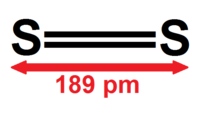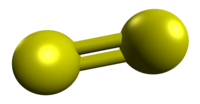二硫
| 二硫 | |
|---|---|

| |

| |
| IUPAC名 Disulfur | |
| 别名 | 双原子硫 二聚硫 |
| 识别 | |
| CAS号 | 23550-45-0 |
| PubChem | 5460602 |
| ChemSpider | 4574100 |
| SMILES |
|
| Gmelin | 753 |
| ChEBI | 29387 |
| 性质 | |
| 化学式 | S2 |
| 摩尔质量 | 64.13 g·mol−1 |
| 偶极矩 | 0 D |
| 热力学 | |
| ΔfHm⦵298K | 128.60 kJ mol−1 |
| S⦵298K | 228.17 J K−1 mol−1 |
| 热容 | 32.51 kJ K−1 mol−1 |
| 相关物质 | |
| 相关化学品 | Triplet oxygen |
| 若非注明,所有数据均出自标准状态(25 ℃,100 kPa)下。 | |
二硫又称双原子硫,是一种由硫构成的双原子分子,其化学式为S2[1]。 二硫是结构最简单的硫分子[2]。其与氧气分子结构类似,但在室温下不易存在,是一个不稳定分子,并具有高反应性[2],其为含硫物质燃烧过程中重要的活性中间体[3]。这种物质在高温低压下的外观为蓝紫色气体[4],并且为热硫蒸气中的主要成分之一。这种气体是木卫一大气的次要成分之一[5]。
合成
[编辑]二硫为硫的双原子分子。在720°C,硫主要以二硫存在,当温度达1000°C时,硫蒸气就几乎是由二硫组成[6]。在530°C、低压(1毫米水银)的环境中,二硫占硫蒸汽的99%。火焰中产生的S2分子使硫燃烧时呈蓝色。[7]。
二硫也可以透过将硫化氢加热至1000°C制得[6]:
在铂催化剂下,二硫亦能在室温下生成[6]:
而大气中的羰基硫在水银光敏感剂的作用下照射紫外光也能生成二硫。二硫化碳(CS2)、过硫化氢(H2S2)、二氯化二硫(S2Cl2)、环硫乙烷(C2H4S)、硫代磷酰氟(PSF3)或羰基硫(COS)的光分解也会生成二硫[8]。
自然存在
[编辑]
尽管在地球上常温环境二硫无法稳定存在,然而在其他行星的卫星上有检测到二硫的存在,例如其为木卫一上大气的次要成分[5],且在该行星的贝利火山喷出的气体中有检测到二硫气体的存在[9]。在行星大气化学中,二硫也是为含硫物质燃烧过程中重要的活性中间体[3],例如苏梅克-列维9号彗星撞击木星后[10],在木星的大气中检测到了二硫分子[9],而在一些彗星的大气[11][12][13]或分子云[14][15]的光谱中亦检测到了二硫分子的谱线。
性质
[编辑]硫蒸气中可能的硫分子包括了二硫、三硫、四硫、五硫、六硫和八硫等,温度越高,二硫在硫蒸气中占的比例就越高,直到温度高于1000°C时,此时硫蒸气几乎由二硫组成[6]。在800°C、气压1毫米汞柱条件下二硫的外观为蓝紫色气体[4]。
二硫是氧气分子的等电子体[6],然而它与其他双原子分子较不同之处为其基态为三重态且第一激发态的能量更高[16]。常温下的硫蒸汽是多种硫分子和自由基所组成,随着温度提升低分子量的硫分子(如二硫、三硫)才会逐渐增加,但仍然是混合物,直到700°C以上二硫才会达到99%以上,这使的对二硫的研究必须在高温下进行,导致对二硫得实验和观测有较高的难度[6]。
然而,其与氧分子不同,高温下的二硫分子冷却到室温后更倾向于凝聚成固态的S8,而不是转变成三重态的二硫分子。因此透过加热生成的二硫分子冷却至室温时不会保留二硫分子的形式[6]。
然而三重态的二硫难以转换成S8[6]。也就是说,一般的情况下,硫加热到足够温度有机会转变成S2,而S2分子冷却后一般转变为环八硫,如影片所示,其中玻璃管上方凝结下的黄色固体就是环八硫。[17]
基态的二硫处于三重态,即带有两个不成对的电子的双自由基,类似于氧气分子和一氧化硫分子。二硫分子中的S-S键长约为189 pm,比S8分子中的S-S键长206 pm还短一些。 其在拉曼光谱中,S-S键的谱线位于715 cm−1处[18],而在氧气分子的O-O键对应的谱线位于1556 cm−1[19]。而S-S键的键能为430 kJ/mol,比O-O键的498 kJ/mol来得低[20]。
单重态的二硫能以亚稳态存在,实验表明高温下二硫从单重态转变为三重态的过程不容易或十分缓慢[21][22][23]。在1000°C的环境下,即使有铂催化剂存在,该反应也不会加速。[6]而单重态的二硫从高稳冷却后会转变成S8[6],是硫的一种同素异形体。硫有多约30种的同素异形体,其特性可以透过其光谱型来区分,在一般条件下,硫最稳定的同素异形体是S8[24]。二硫相对来说显得不太稳定。此外,二硫容易光分解[3]。在太阳光下,二硫的半衰期约为7.5分钟[11]。
参见
[编辑]参考文献
[编辑]- ^ Steudel, Ralf; Eckert, Bodo. Solid Sulfur Allotropes. Elemental Sulfur and Sulfur-Rich Compounds I. Topics in Current Chemistry 230. 2003: 58–68. ISBN 978-3-540-40191-9. doi:10.1007/b12110.
- ^ 2.0 2.1 Andrzej Z. Rys and Erwin K.V. Schultz and David N. Harpp. Quest for diatomic selenium. Journal of Sulfur Chemistry (Taylor & Francis). 2010, 31 (5): 351–371. doi:10.1080/17415993.2010.513440.
- ^ 3.0 3.1 3.2 Frederix, Pim W. J. M.; Yang, Chung-Hsin; Groenenboom, Gerrit C.; Parker, David H.; Alnama, Koutayba; Western, Colin M.; Orr-Ewing, Andrew J. Photodissociation Imaging of Diatomic Sulfur (S2)†. The Journal of Physical Chemistry A. 2009, 113 (52): 14995–15005. Bibcode:2009JPCA..11314995F. ISSN 1089-5639. PMID 19754091. doi:10.1021/jp905104u.
- ^ 4.0 4.1 Macintyre, J.E. Dictionary of Inorganic Compounds. Taylor & Francis. 1992. ISBN 9780412301209.
- ^ 5.0 5.1 Lellouch, E. Io's Atmosphere and Surface-Atmosphere Interactions. Space Science Reviews. January 2005, 116 (1–2): 211–224. Bibcode:2005SSRv..116..211L. doi:10.1007/s11214-005-1957-z.
- ^ 6.00 6.01 6.02 6.03 6.04 6.05 6.06 6.07 6.08 6.09 Startsev, AN. Diatomic sulfur: a mysterious molecule. Journal of Sulfur Chemistry (Taylor & Francis). 2019, 40 (4): 435––450.
- ^ Greenwood, N. N.; Earnshaw, A. Chemistry of the Elements 2nd. Oxford:Butterworth-Heinemann. 1997. ISBN 0-7506-3365-4.
- ^ Tardif, Sylvie L.; Rys, Andrzej Z.; Abrams, Charles B.; Abu-Yousef, Imad A.; Lesté-Lasserre, Pierre B. F.; Schultz, Erwin K. V.; Harpp, David N. Recent chemistry of the chalcogen diatomics. Tetrahedron. 1997, 53 (36): 12225–12236. doi:10.1016/S0040-4020(97)00555-3.
- ^ 9.0 9.1 Spencer, J. R. Discovery of Gaseous S2 in Io's Pele Plume. Science. 2000, 288 (5469): 1208–1210. Bibcode:2000Sci...288.1208S. ISSN 0036-8075. PMID 10817990. doi:10.1126/science.288.5469.1208.
- ^ Noll, KS and McGrath, MA and Trafton, Laurence M and Atreya, SK and Caldwell, JJ and Weaver, HA and Yelle, RV and Barnet, C and Edgington, S. HST spectroscopic observations of Jupiter after the collision of comet Shoemaker-Levy 9. Science (American Association for the Advancement of Science). 1995, 267 (5202): 1307––1313.
- ^ 11.0 11.1 Ahearn, M. F.; Schleicher, D. G.; Feldman, P. D. The discovery of S2 in comet IRAS-Araki-Alcock 1983d. The Astrophysical Journal. 1983, 274: L99. Bibcode:1983ApJ...274L..99A. ISSN 0004-637X. doi:10.1086/184158.
- ^ Grim, RJA and Greenberg, JM; et al. Photoprocessing of H2S in interstellar grain mantles as an explanation for S2 in comets. Astronomy and Astrophysics. 1987, 181: 155––168.
- ^ Kim, Sang J and A'Hearn, Michael F and Larson, Stephen M. Multi-cycle fluorescence: Application to S2 in comet IRAS-Araki-Alcock 1983VII. Icarus (Elsevier). 1990, 87 (2): 440––451.
- ^ Liszt, HS. Upper limits on the abundance of the sulfur dimer in molecular clouds. The Astrophysical Journal. 1978, 219: 454––457.
- ^ Mitchell, GF. Effects of shocks on the sulfur chemistry of a dense interstellar cloud. The Astrophysical Journal. 1984, 287: 665––670.
- ^ Swope, William C and Lee, Yuan-Pern and Schaefer III, Henry F. Diatomic sulfur: Low lying bound molecular electronic states of S2. The Journal of Chemical Physics (American Institute of Physics). 1979, 70 (2): 947––953.
- ^ 无机化学丛书 第五卷 氧 硫 硒分族. pp 164
- ^ Eckert, Bodo; Steudel, Ralf. Molecular Spectra of Sulfur Molecules and Solid Sulfur Allotropes. Elemental Sulfur and Sulfur-Rich Compounds II. Topics in Current Chemistry 231. 2003: 181–191. ISBN 978-3-540-40378-4. doi:10.1007/b13181.
- ^ Hill, R.A.; Esherick, P.; Owyoung, A. High-resolution stimulated Raman spectroscopy of O2. Journal of Molecular Spectroscopy. 1983, 100 (1): 119–133. doi:10.1016/0022-2852(83)90029-2 (英语).
- ^ (Lide, David R. (编), CRC Handbook of Chemistry and Physics 87th, Boca Raton, FL: CRC Press, 2006, ISBN 0-8493-0487-3
- ^ А. Н. Старцев, О. В. Круглякова, С. Ф. Рузанкин, Н. Н. Булгаков, Ю. А. Чесалов, Е. А. Кравцов, В. И. Жейвот, Т. В. Ларина, Е. А. Паукштис. Особенности низкотемпературного каталитического разложения сероводорода. Журнал физической химии. 2014, 88 (6): 943–956 [2020-05-07]. ISSN 0044-4537. doi:10.7868/S004445371406034X (俄语).
- ^ Startsev, AN and Bulgakov, NN and Ruzankin, S Ph and Kruglyakova, OV and Paukshtis, EA. The reaction thermodynamics of hydrogen sulfide decomposition into hydrogen and diatomic sulfur. Journal of Sulfur Chemistry (Taylor & Francis). 2015, 36 (3): 234––239.
- ^ A. N. Startsev. Low-temperature catalytic decomposition of hydrogen sulfide into hydrogen and diatomic gaseous sulfur. Kinetics and Catalysis. 2016-07, 57 (4): 511–522 [2020-05-07]. ISSN 0023-1584. doi:10.1134/S002315841604011X (英语).
- ^ A. F. Holleman, N. Wiberg. Inorganic Chemistry. Academic Press; Berlin; New York: De Gruyter, 2001.ISBN 0-12-352651-5

![{\displaystyle {\ce {2H2S<=>[\Delta {\text{ T}}]2{H2}+{^{1}S2_{(gas)}}}}}](https://wikimedia.org/api/rest_v1/media/math/render/svg/ea5aa4b4904e79738ccf86409623b2b65e9a964a)
![{\displaystyle {\ce {2H2S->[{\text{metal, RT}}]2{H2}+{^{3}S2_{(gas)}}}}}](https://wikimedia.org/api/rest_v1/media/math/render/svg/2ee50ea164a2c126ead6a27c4951e3ce6fa054ae)


